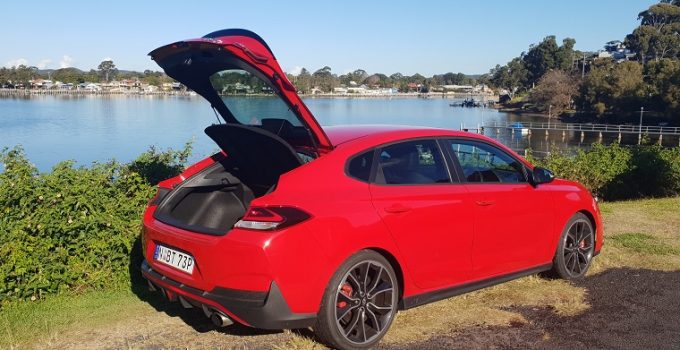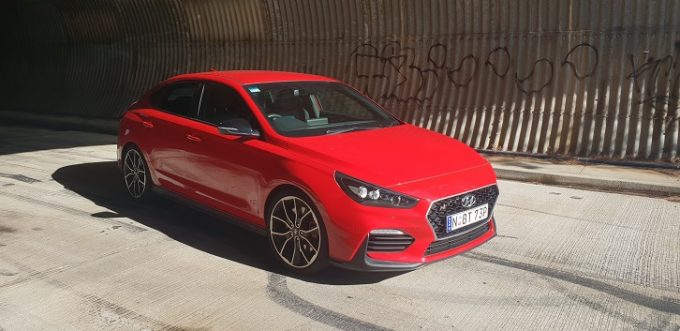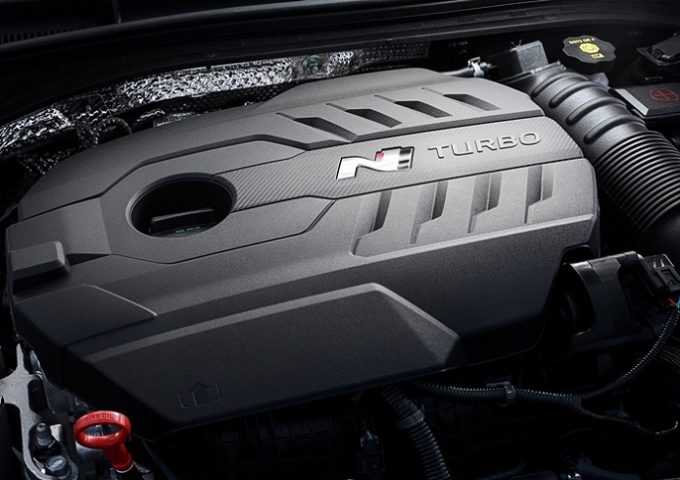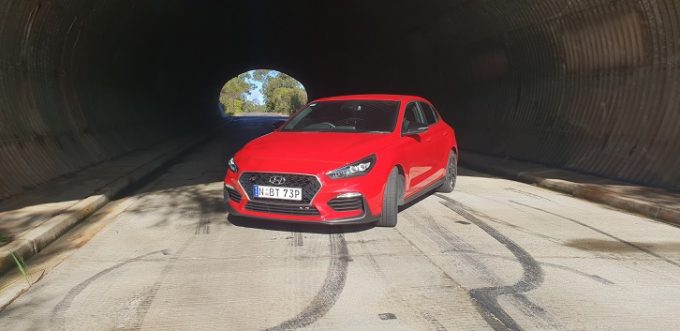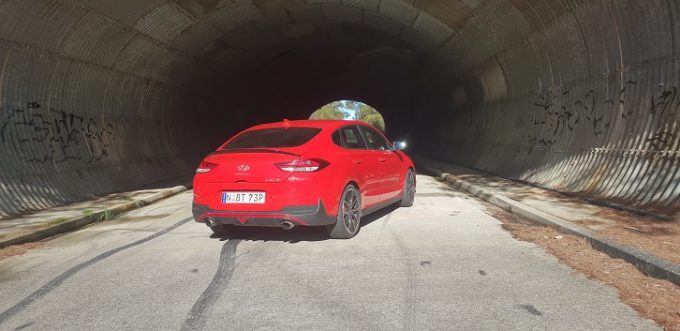Hyundai has successfully reinvented its image from humble origins to a competitive juggernaut that gives Toyota nightmares. After winning the hearts and minds of everyday car consumers and luxury car consumers with its Genesis line of products, Hyundai set its sights on the true driving enthusiast.
Having already found themselves with a solid platform, Hyundai enlisted the help of former head of BMW’s M Division, Albert Biermann. The appointment of such a well-known legend was a step that established pedigree and the first product of the resultant N performance division, the i30 N, exceeded expectations.
Earlier this year, the hatchback version of the i30 N was joined by a five-door fastback, which also includes additional suspension tweaks. At $41,990, we set off to find out what the fuss is about for ourselves against Top 10 Cars’ unique criteria.
2019 Hyundai i30 N Performance Fastback Review: Cabin Space and Comfort
As it is based on the i30 hatchback, the i30 N Fastback is dimensionally similar, save for a boot which is 55 litres more generous at 436L, or 1337L when the rear seats are folded. A rigidity-adding steel beam sits immediately behind the rear seats, but is low enough to not impede the luggage area too much.
While our car was not equipped with the $3000 Luxury Pack, the seats were comfortable, well-bolstered and even featured a BMW-style extendable thigh cushion. A 2650mm wheelbase means that rear legroom is on the generous side for the segment, with headroom seemingly not affected by the car’s tapering silhouette.
2019 Hyundai i30 N Performance Fastback Review : Infotainment and Ergonomics
As it is based on one of Australia’s consistently best-selling cars, ergonomics and controls are logically and intuitively placed. The infotainment screen is user-friendly with crisp graphics and pleasing visuals- particularly when the driving modes are displayed.
Uniquely, the drive mode can either be selected with a seperate control on the centre console, or on the steering wheel using the “N” button, which we’ll expand on later.
2019 Hyundai i30 N Performance Fastback Review: Design
The i30 N is the only mainstream fastback, or ‘four-door coupe’ in its segment. Stylistically, comparisons with the Mercedes-Benz CLA are inevitable, not to mention the upcoming BMW 2 Series Gran Coupe. The fact that these cars are being mentioned is flattering considering the i30 N’s price point.
Styling is definitely a subjective thing. The car does look confident and retains the presence of the hatch, with a distinctive integrated ducktail at the back. Does the car strike the kind of proportional balance of the aforementioned Euros? You be the judge.
Hyundai Australia is restricting the fastback bodystyle to the i30 N for now, which is available overseas in lower spec variants. This does add to the premium factor.
The interior definitely gives a sense of occasion, with great attention to detail. Examples of this include the digital bars in the tachometer that suggest maximum revs based on engine temperature. This is definitely a nod to Albert Biermann’s BMW M days and we love it.
Its 300km/h speedometer is ambitious but ten kilometre increments and digital speedometer function means you always know how fast you’re going.
2019 Hyundai i30 N Performance Fastback Review: Engine and Performance
The 2.0-litre, turbocharged ‘Theta-II’ engine is utilised in other Hyundai products such as the Sonata, but here it takes on an eminently more exciting persona.
Switching the car into ‘N’ mode increases the volume and depth of the engine note, with delicious pops and crackles on overrun to bring a smile to your face.The fact this can be switched on or off depending on your mood means it never becomes tiresome. Throttle response is noticeably sharper and the adaptive damping firms up when the button is pressed as well.
Due to the Fastback’s slipperier drag coefficient of 0.297Cd vs 0.32Cd for the hatch, the quoted 0-100km/h time falls from 6.2-seconds to 6.1. This estimate feels conservative and there have been many examples of it dropping below that.
In the wet, the front tyres can be overwhelmed with a heavy-handed take-off, but torque steer was not evident.
The engine produces 202kW @ 6000rpm and 353Nm @ 1450-4700 rpm, but has an overboost function that increases torque to 378Nm for up to 18 seconds.
How this feels in the real world is muscular, with a juicy mid-range surge of torque and a rewarding top end sizzle.
In Eco and Normal driving modes, throttle response is still sharp enough for fast getaways, and without the take-off lag that plagues some other modern turbo vehicles.
The Fastback’s characterful engine and prodigious torque mean it delivers great performance.

2019 Hyundai i30 N Performance Fastback Review: Transmission
If you prefer automatic transmission, you will have to wait until around the end of the year for a new, eight-speed dual clutch transmission, or try the 150kW i30 N-Line instead. The sole manual gearbox on offer offers nice shift quality, if not the best we’ve ever experienced and works superbly with the torquey engine.
To live with on a daily basis, the fact that torque is available off idle means it’s impossible to stall. The clutch pedal feels about right too, not overly heavy. In ‘N’ mode, a rev-matching feature on downshift blips the throttle for you. Luckily, there’s a seperate button to turn that off, and the pedals are well-positioned for heel-and-toe if you want to do it yourself.
2019 Hyundai i30 N Performance Fastback Review: Handling and Steering
Hyundai’s Australian development team picked a chassis tune for the N Performance hatchback that was lauded as world’s best. For the Fastback version which debuted earlier this year, further tweaks were made, including a larger bump stop and a rear camber control arm –the latter of which makes the car capable of lift-off oversteer. This chassis tune will be adopted for the hatch before year’s end.
In practice, the rack-mounted electric steering pump gives the steering a confidence-inspiring feel with palpable feedback. It is linked to a chassis that has many tricks up its sleeve and a breadth of adjustability which eludes its rivals.
In N mode, with the firmest setting on the dampers and most lenient setting for the electronic stablity program, this reviewer discovered the joy of lift-off oversteer for the first time. Throwing the car into a 90 degree turn, backing off the throttle and a quick stab of the brakes provokes the rear into a beautifully controlled slide, preserving the momentum with the deftness of an Olympic figure skater.
Who said you need a $57,000 Ford Focus RS with Drift Mode for hot hatch, tail-out antics? To novice drivers, take comfort in the fact that this is not something you can accidentally trigger.
In sharp corners, the chassis is deliciously grippy with the limited slip differential biting hard into the inside corner. The car’s 1441kg remains balanced at all times thanks to the mechanical and electronic chassis prowess of this car.
Brakes, unusually, are single piston calipers all round, with 345mm discs up front, and 312mm at the rear — all vented. They washed off speed with authority and didn’t fade even after a repeated hard stops. Unlike other top-spec i30’s, this variant has retained the old-fashioned mechanical handbrake, which is a trend we’d like to see continue.
We were expecting the car to be quite good in this regard, but didn’t expect this level of brilliance.
2019 Hyundai i30 N Performance Fastback Review: Ride and NVH
Ride is far more forgiving than it has any right to be, even in ‘N’ mode. Of course, there are times where you feel the performance bias, but only over the very sharpest of bumps. Hyundai’s local engineers have done well to create a suspension of disbelief (excuse the pun).
Otherwise noise is well contained like the regular i30, except when the bi-modal exhaust is engaged in ‘N’ mode, but that rich fruity tingle is not unwelcome, and can be switched off at any time.
2019 Hyundai i30 N Fastback Review: Fuel economy and running costs
Average fuel consumption is quoted at 8L/100km, which matched our efforts during normal driving. The fuel tank has a capacity of 50 litres, which means good cruising range on long distance.
Servicing will cost you an average of $319 vs 277 for 1.6T/2.0- litre equipped i30s.
2019 Hyundai i30 N Performance Fastback Review: Safety
The base vehicle boasts a five star ANCAP rating, and this version features additional chassis bracing, and therefore higher torsional rigidity.
It also features forward collision alert, driver fatigue monitoring and lane keep assist, but autonomous emergency braking including pedestrian and cycling detection will be available at a later date.
The car’s much larger brakes which help the car achieve a much shorter stopping distance boost the car’s active safety credentials no end. You can find a safety report for the regular i30 here, but disregard any mention of AEB (for now).
2019 Hyundai i30 N Fastback Review : Value for Money
As a performance car, $41,990 undercuts many rivals while offering a more adjustable chassis and superior engine to most.
An optional Luxury pack adds satnav, auto-on lights and wipers, dual zone climate control, DAB+ and more for $3000, or $5000 with a panoramic roof on top.
As with other Hyundais, a five year/unlimited km warranty and roadside assistance package, which astoundingly, also includes track coverage on the former.
2019 Hyundai i30 N Performance Fastback Review: Conclusion
Everything comes together so beautifully in the i30 N Fastback that the sum total is an exceptionally good value hot hatch, with a character and pedigree of its own.
The seat-of-the-pants impression of this car is that it feels like it’s from the Ford Focus RS/ Volkswagen Golf R class, rather than ST or GTI, which is exactly the kind of splash that Hyundai is seeking to make.
Upcoming rivals in the form of the next Ford Focus ST 2.3 and Volkswagen Golf GTI Mk VIII have a Herculean task ahead of them if they hope to equal-let alone leap-frog- the i30 N Performance.

